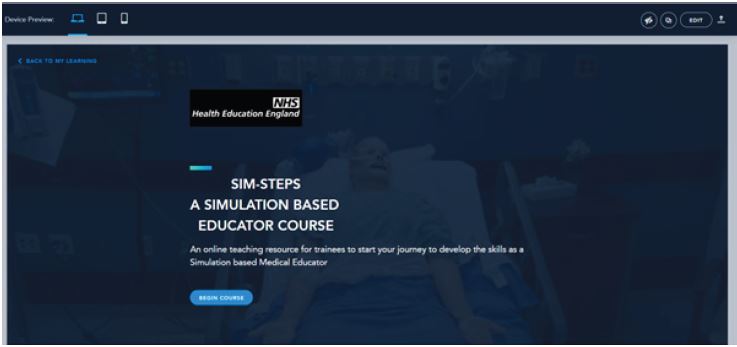
At present there are limited resources for simulation faculty development and educators are unable to access face-to-face courses uniformly across the region. Currently available online resources lack interactive reflective activity and recorded faculty videos which leads to a less engaging and effective learner experience. We aimed to create a structured and accredited simulation faculty development course on the Bridge online platform for educators who are novice in simulation-based education using a blended learning approach by incorporating recorded faculty videos and current available resources on eLearning For Healthcare (eLFH), Scottish Simulation framework and provide a platform with links to online resources.
A scoping review was conducted to review current available online resources and face to face courses across the East of England region. Faculty across the region were contacted to understand the learning objectives, outcomes, and content of their courses. A survey was sent out to Bridge users across the region to determine how best to deliver the simulation faculty development course and whether they would find a Bridge course useful. We received 158 responses of which 94% respondents were keen to develop their simulation education skills, 74% had not received any formal training, and nearly 90% wanted a blended learning course.
SIMSTEPS has been developed following a detailed gap analysis and scoping review. The course has been designed incorporating the eLFH learning modules, the Scottish framework for Simulation Faculty development. It does not replace face to face teaching but gives a starting point to develop the learners’ knowledge and skills about simulation-based education which can be enhanced further in face-to-face courses or workshops. Modules have been developed on key topics relevant to simulation-based education [1] with links to videos, recorded Faculty sessions, and online educational resources. Learners are encouraged for continuing reflective practice [2] and prompted to reflect after modules. The course would be accessible to all Bridge users (Interprofessional educators) in the East of England at no cost and can be completed by them at their own pace and time. We planned meticulously to ensure the course content meets learning objectives and ensured quality assurance by independent review of the course by established and experienced faculty.
Post-course evaluation by learners will be done on course completion.
A blended learning course like SIM-STEPS can potentially provide an effective resource on Simulation faculty development and improve learner experience and engagement.

1. Motola I, Devine LA, Chung HS, Sullivan JE, Issenberg SB. Simulation in healthcare education: a best evidence practical guide. AMEE Guide No. 82. Medical teacher. 2013;35(10):e1511–1530.
2. Brydges R, Manzone J, Shanks D, Hatala R, Hamstra SJ, Zendejas B, Cook DA. Self‐regulated learning in simulation‐based training: a systematic review and meta‐analysis. Medical education. 2015;49(4):368–378.